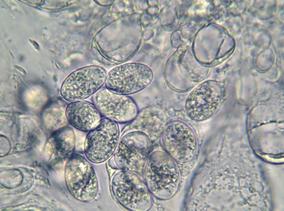You are here
All Fungi
Verrucaria hydrophila
Nomenclature
-
Family: VerrucariaceaeGenus: Verrucaria
SUMMARY
Thallus thin, 25–60 µm thick, smooth, continuous or sparsely cracked, grey-green to mid-brown, ± translucent when fresh and wet. Cells irregularly arranged, at most with a very weak vertical arrangement, coherent, with no air spaces between them. Cortical pigment, when present, brown. Adjacent conspecific thalli never separated by dark lines.
Anamorph: not known.
Teleomorph: ascomata perithecia, forming conical-hemispherical mounds 240–400 µm diam., at first covered to the apex by a layer of thallus, later with the black apex of the involucrellum sometimes exposed. Ostiolar area inconspicuous, plane or convex, appearing as a pale dot 15–50 µm diam. Involucrellum conical, extending below to the substratum, densely pigmented on the upper part, often becoming almost hyaline adjacent to the base of exciple; pigment dark brown to dark reddish brown, K+ darker brown to grey-brown. Ascomata 145–225 µm diam., colourless except at the apex. Interascal tissue absent, but periphyses and periphysoides present. Asci clavate, I–, fissitunicate, the wall thickened above, ocular chamber usually present; dehiscence by extrusion of an endotunica to form a delicate rostrum, 8-spored. Ascospores arranged biseriately, (15–) 19.5–23 (–26) x (6.5–)8–9.5 (–11) µm, (1.7–) 2.2–2.6 (–3.3) times as long as wide, ellipsoidal, hyaline, aseptate, thin-walled, perispore not seen.






